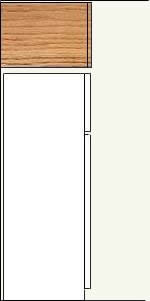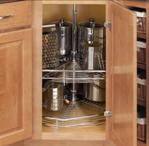North Americans have been spoiled, most of us grew up in homes with large kitchens, with plenty of counter space. Kitchens were the family gathering place and doubled as the family room. However, things are changing, more and more homes have much smaller kitchens, with limited counter and cabinet space (Figure 1), especially in duplexes, four-plexes, apartments and condominiums.

Figure 1 - Small kitchen with limited countertop and cabinet space
Small kitchens equate to less counter space at a time when there is an increasing variety of small appliances and kitchen gadgets.
How can you work in a kitchen with a countertop that is covered in appliances and gadgets?
It is important to make use of all the space available.
Cabinets:
In many instances cabinets do not go to the ceiling and areas above refrigerators are not utilized for cabinet space properly. As an example, cabinets above refrigerators should not be inset, as shown in Figure 2. They should be mounted with the same depth as the refrigerator, as shown in Figure 3.

Figure 2 - Over refrigerator kitchen cabinets mounted behind face of refrigerator is not an efficient use of space.

Figure 3 - Over refrigerator kitchen cabinets mounted flush with face of refrigerator is a more efficient use of space.
The installation of wall (Figure 4) and base (Figure 5) corner cabinets allow for accessible use of space in the corners of kitchens. Blind cabinets have a lot of dead space.

Figure 4 - Corner kitchen wall cabinet

Figure 5 - Corner kitchen base cabinet
If you do have a blind cabinet, but are not prepared to invest in new kitchen cabinets, you can purchase "blind corner optimizers" for both wall (Figure 6) and base (Figure 7) cabinets.

Figure 6 - Blind corner wall cabinet optimizer

Figure 7 - Blind corner base cabinet optimizer
Cabinets that are above working countertop areas can be made thinner (less depth), exposing more of the counter top.
Better use of kitchen cabinets: Using adjustable rather than fixed shelving in cabinets can, in many instances, provide an extra shelf.
If your cabinet shelves cannot be easily converted to adjustable shelving consider the use of racks (Figure 8) and stands (Figure 9) to provide additional, convenient storage.

Figure 8 - Cabinet shelf rack

